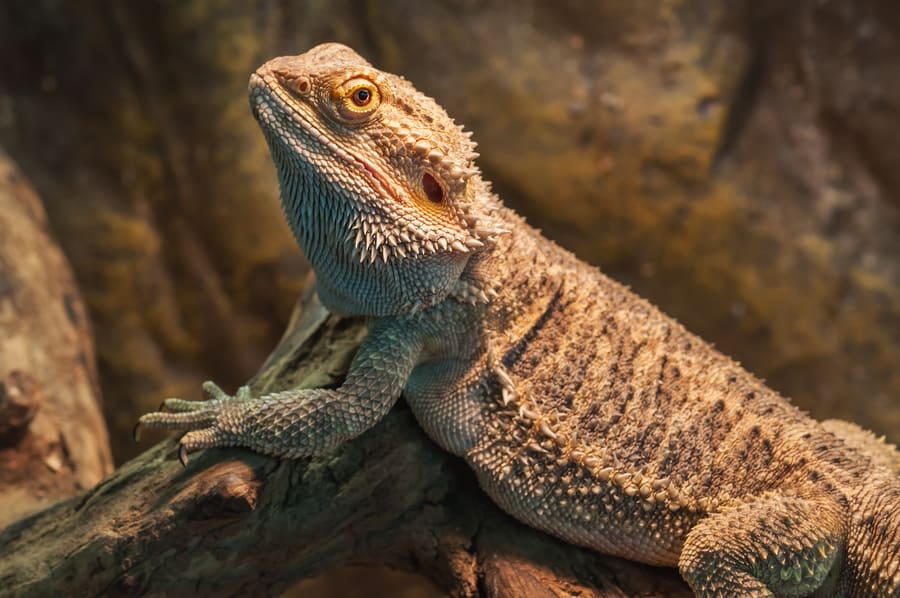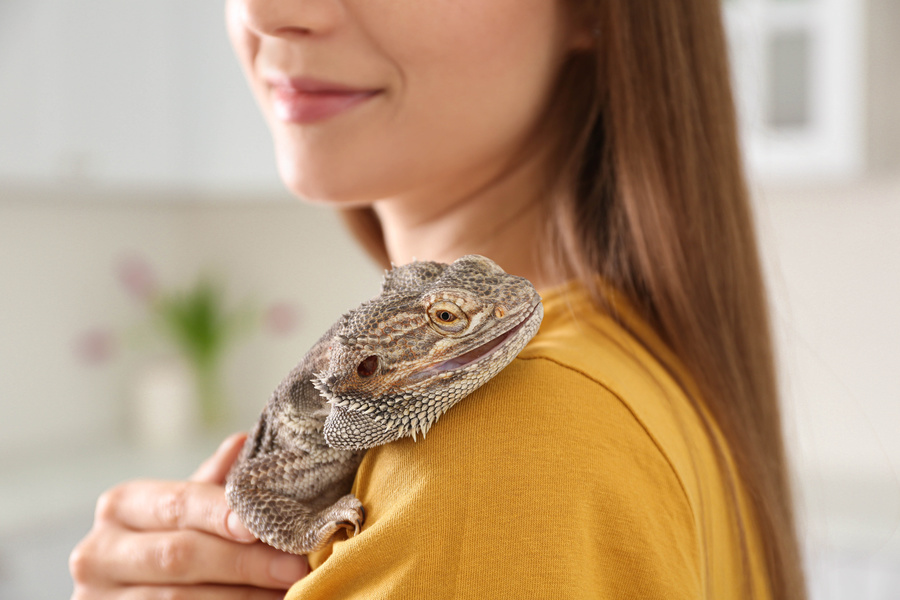
If you are a pet owner who is looking for a reptile friend, you probably found that the bearded dragon is one of the first few pets recommended because of their mild-mannered temperament. However, you may be wondering whether bearded dragons require a lot of upkeep.
Bearded dragons are not a lot of work to successfully although they do have food and supervision requirements that may present a unique challenge. Overall, bearded dragons are probably the easiest pet reptile you can own.
In short, bearded dragons require about the same level of care as other reptiles, but they also have some special requirements, particularly food and stronger supervision. Fortunately, with some knowledge of the bearded dragon, one can still be a successful owner—even if they have never owned a reptile before.
I have raised multiple bearded dragons from babies through old age. I believe they are one of the easiest-to-care-for pet reptiles out there. I hope you find real value in this article.
Essentials for Keeping Healthy Bearded Dragons
Food Requirements
A bearded dragon should be fed a mix between insects (about 75%) and vegetables (about 25%), along with the occasional fruit. Overall, bearded dragons eat typical insects for reptiles—for example, crickets, mealworms, and kingworms.
However, they have a fairly restrictive diet for vegetables, so the owner should be aware of foods the bearded dragon can and cannot eat. For example, they should not have onions, garlic, leeks, avocados, or rhubarb (among others, always check that a certain fruit or vegetable is safe before feeding it).
Personal Experience: I found mealworms and crickets to be the easiest meal to get bearded dragons to consistently eat. Even freeze-dried crickets can be a suitable food source once they are trained to eat them.
For a complete guide to feeding freeze-dried crickets to all types of lizards including bearded dragons, please check out this helpful article I wrote.
Water Requirements
A bearded dragon should have access to fresh water at all times. To ensure this, the owner should have a small, shallow bowl and ensure that fresh water is constantly available. However, the owner should not use tap water.
Bearded dragons instinctively struggle to drink water from a bowl, so it will require adjustment, especially at first. One way to help them adjust is to add freshly squeezed (not store bought, as these contain added sugar and potentially other unhealthy products) strawberry or papaya juice, which will attract them with the scent.
Fortunately, because they have fruits and vegetables in their diet, particularly leafy greens, they can derive some of the needed water through diet alone.
Cleaning Requirements
To ensure the health of the bearded dragon, the owner should clean the tank regularly. If they are able to set aside time each day to do a quick clean-up of the terrarium (removing stools, cleaning dirty water/food dishes, etc.), they should only need to do a thorough clean once a month.
However, some owners may not have this time investment—if that is the case, they can still clean whenever possible (at least once every other day).
Terrarium Needs
To ensure that the owner can see the bearded dragon (and also so it is aware of its environment), they should invest in a clear glass terrarium. Although the terrarium does not need to be very high, it should be long and fairly spacious (at least 48 inches long, 24 inches wide, and 24 inches high).
Many people find the front sliding doors more accessible, but there is nothing wrong with having the lid on top (if on top, should also have screen lid, especially if the owner has other pets.
Substrate Suggestions
Pet stores offer a variety of substrates for reptiles—sand, moss, wood chips, even reptile carpet. However, the loose items can cause compaction, and the reptile carpet tends to have chemicals that may be harmful to a bearded dragon.
Although they are not as visually appealing, paper towels are the best substrate (and a lot cheaper/easier to maintain!). Absorbent for messes, easy to clean terrarium (just need to remove and replace), no danger of compaction.
Also, loose substrate can easily get stuck in the eyes and nose, causing infection. Paper towels will not cause infection as long as they are replaced regularly. As long as no ink is on there, it does not have toxic substances for a bearded dragon.
Temperature/Humidity Needs
The bearded dragon’s terrarium should have two sections—a cooling area and a basking spot—to ensure that the bearded dragon can maintain a healthy temperature. In the daytime, the overall temperature should be 75 to 85 degrees Fahrenheit, and the basking area should be 88 to 100 degrees Fahrenheit. During the nighttime, the temperature should be 70 to 75 degrees Fahrenheit.
To monitor the temperatures, the owner should have two thermometers in the tank for each area. The owner may wish to use a heating pad to maintain temperature; if they do, they should ensure that the terrarium is on a non-wood fixture and/or lifted up high enough to prevent fire hazards.
Also, heating lamps can be used for the daytime. However, heating rocks can burn the reptile and should never be used. Since bearded dragons naturally prefer a drier habitat, the humidity should be at 20 to 40%. To ensure the humidity is at the proper level, the owner should use a hygrometer.
While it should not be damp, the habitat should not be too dry, or the bearded dragon will have shedding issues. To prevent this, the owner can use a spray bottle (again, not using tap water) to lightly moisten the terrarium.
Lighting Requirements
During the daytime, the bearded dragon should have a UV light for 12 hours a day during the warmer months and 8 hours a day in the cooler months. At night, the terrarium should have a ceramic bulb for heat, but not a red bulb since the reptile can see the light emitted.
Personal Experience: For a year, I made the mistake of using a red bulb because a friend said it would be good. My beardie ended up always seeming anxious as a result. Once I removed the red light, he was able to rest better and was much more relaxed.
Additional Supplies
The bearded dragon should have at least one shelter in the cool area, so it can feel safe. Also, it should have a housing/shelter in the warm area, so it can either feel safe or bask in the light.
Although they tend to stay on the ground, bearded dragons also enjoy climbing a bit. Either artificial or real plants (such as aloe or palms) can be used.
Maintenance Level: Compared to Other Lizards
Because bearded dragons require specialized equipment, such as lighting and housing, they are considered fairly expensive. They are larger reptiles (up to two feet), so they do require a larger terrarium than most. Also, they need to spend more time running around the house, which demands strong attention on the owner’s part.
Their initial costs, including the actual dragon and supplies, range anywhere from $300 to $600, as opposed to the leopard gecko (an average lizard), which costs about $120 upfront.
Finally, unlike most other lizards, bearded dragons need both insects and fruit/vegetables (although baby dragons should only eat insects). The owner may struggle to create a well-balanced diet, which involves managing these costs, know what food the dragon should and should not eat, and create a well-balanced diet.
Need both vegetables and insects, unlike a lot of other lizards (which are usually insectivores). Can be difficult to manage costs and have well-balanced diet for them.

Can bearded dragons be left alone for extended periods of time?
Although bearded dragon owners should not leave their pets for extended periods of time, they can do so for one to two days with some preparation. Three days is a bit of a stretch, and four days requires strong preparation. Any absence beyond this period without some sort of supervised feeding, watering, and cleanup causes problems.
If the owner needs to leave for a few days, they can use scheduled lighting, which allows the day light to be turned on and off to provide a secure sleep schedule. They should also set the thermostat temperature above 65 degrees or use a ceramic heater when the lights are off.
The day of or before the leaving period, the owner should clean the cage thoroughly. Finally, the owner should make sure the water container is full and the bearded dragon is provided a large meal immediately beforehand.
During the actual trip, the owner may even consider a webcam. If at all possible, they should have someone else take care of the bearded dragon while they are away.
Personal Experience: I’ve left my bearded dragons alone for 2 days without issue. It is still recommended, you have a pet sitter stop by to ensure all is well.
Do bearded dragons get lonely?
Although bearded dragons are friendly to their owners, they do not get lonely because they are naturally solitary creatures. In fact, they prefer living alone as opposed to sharing a terrarium with other bearded dragons. For a complete breakdown of pairing bearded dragons with other bearded dragons and other reptiles, and if you should do it, please check out this helpful article I wrote.
Are Bearded Dragons Beginner/Kid-Friendly?
From my experience, bearded dragons are the most kid-friendly lizard because of their docile nature, tolerance for handling, and subdued demeanor. They are like a pet dog in a lot of ways.
Yes, bearded dragons are a wonderful pet for beginners and children. Even if they are sometimes expensive, bearded dragons are mild-mannered and easy to handle. However, because they require specialized care, parents should supervise their children closely, and beginners should read up on bearded dragons thoroughly before purchasing one.
Should You Take them out of their enclosure frequently?
Bearded dragons should be taken out of their enclosure frequently. In fact, they can become stressed if they are not allowed out of enclosure at least occasionally, and the sunlight can help them stay healthy (especially if they are allowed to be in a controlled environment outside).
However, the bearded dragon should also be supervised in a controlled environment without pets or other potential dangers around. Also, the owner should constantly ensure that the bearded dragon is not getting too cold, especially if it is let outside.
When letting them out initially, the owner may find that the bearded dragon is nervous and even spooks. This is normal behavior, which is why the owner should start out small (for example, starting inside and gradually moving outside) and constantly supervise.
Personal Experience: My sister used to practically sleep with her bearded dragon growing up. I think you should definitely bring them out of their enclosure daily to get them used to your presence.
Thoughts on Owning Bearded Dragons & Work Involved
Benefits of Owning Bearded Dragon
As mentioned before, bearded dragons are very friendly and mild-mannered. Because of this, they are also tolerant of handling and naturally quiet. Also, they are fairly lightweight (500 grams on average) and have unique morphs and colorations.
Finally, they have a good lifespan of up to 10 years (although, if someone is looking for a short-term pet, this may also be a con).
Negatives of Owning Bearded Dragon
Although they have many benefits, they are somewhat high-maintenance. For example, they require a larger tank, and they need feeding every day (as opposed to some other reptiles, such as leopard geckos, that only need to be fed every other day).
Also, bearded dragons have salmonella in their feces, although this is also common in other reptiles. They have a bad stool smell, which may require more frequent terrarium cleanings.
Finally, the typical bearded dragon requires quite a bit of food—about 25 crickets per meal. Along with the sheer quantity, bearded dragons need a well-balanced diet with vegetables and a carefully selected range of food items.
Which Sex of Bearded Dragon is Better?
I have found both sexes have their pros and cons. Male bearded dragons are more energetic and females are calmer.
Neither sex is inherently better. While males are more energetic, females are more mild-mannered, so it completely depends on the nature of the household. Bearded dragons should not be put together regardless of sex, so this is not a major setback for a male (even though they do not do well with other males).
